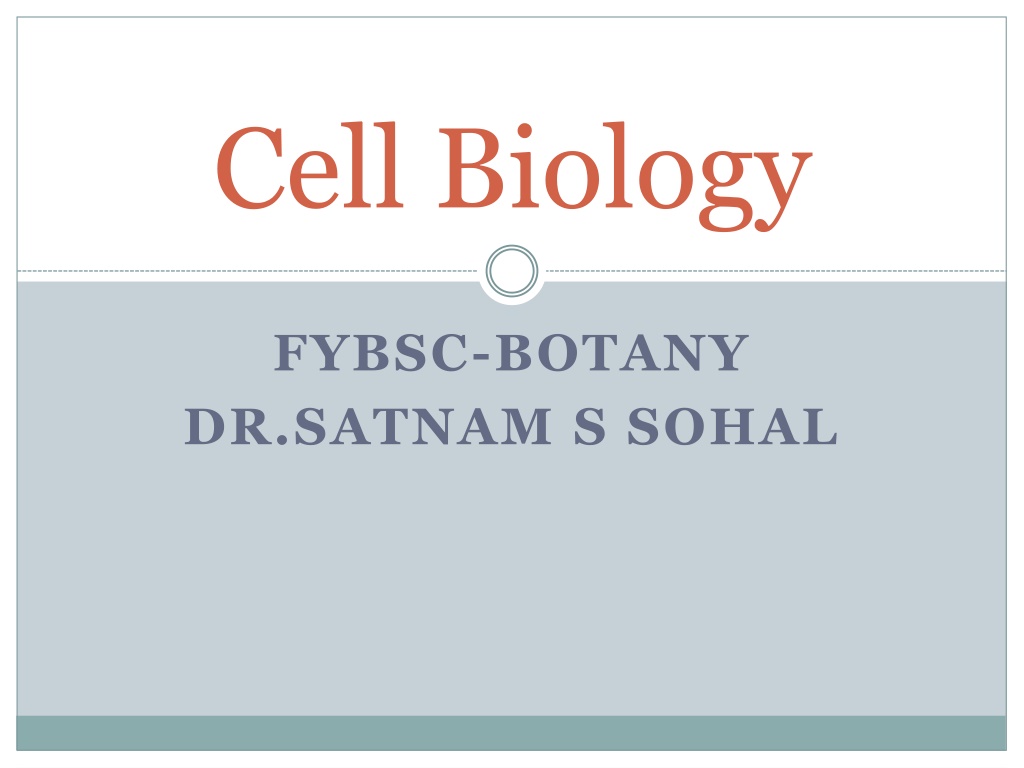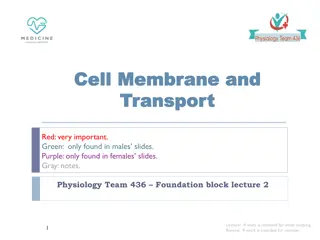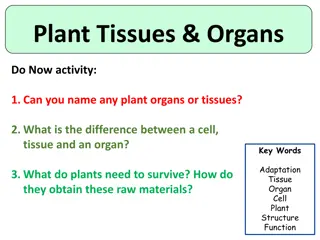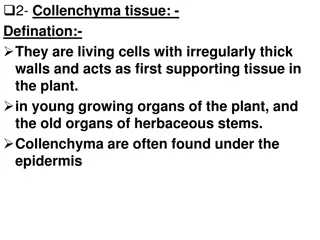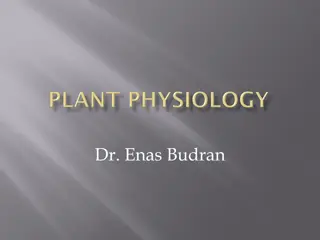Understanding Plant Cell Walls: Structure and Function
Plant cell walls play a crucial role in providing structure and protection to plant cells. This article delves into the composition of primary and secondary cell walls, highlighting the presence of cellulose, pectins, and glycans. The secondary cell wall, rich in lignin, offers mechanical support, especially in xylem cells. Furthermore, the middle lamella with pectins and plasmodesmata aid in cell connections and material transport between cells.
Download Presentation

Please find below an Image/Link to download the presentation.
The content on the website is provided AS IS for your information and personal use only. It may not be sold, licensed, or shared on other websites without obtaining consent from the author. Download presentation by click this link. If you encounter any issues during the download, it is possible that the publisher has removed the file from their server.
E N D
Presentation Transcript
Cell Biology FYBSC-BOTANY DR.SATNAM S SOHAL
Cell wall Cell wall is the outermost wall of a cell present exterior to plasma membrane. Cell walls are rigid in a plant cell. whereas in animals, cell wall is absent and only cell membrane is present. Cell wall performs number of functions Cell wall is thicker than the plasma membrane and it protects the intracellular content. Plant cells have primary cell wall when the cell is growing and it develops a secondary wall after it is fully developed and stops growing.
Cell wall Secondary cell wall is thicker as compared to primary wall. The main component of the primary plant cell wall includes Cellulose in the form of organized micro fibrils a complex carbohydrate made up of several thousand glucose molecules linked together. Pectins which are branched. Glycans cross linked
Cell wall The three components are organized into a network Along with cellulose microfibrils,the cross linked glycans increase the tensile strength of cell wall whereas the network of pectin's provide cell wall with the ability to resist compression. Small amount of proteins are also present in the plant cell wall. Secondary plant cell wall is often deposited inside the primary wall as cell matures. he secondary cell wall is a structure found in many plant cells, located between the primary cell wall and the plasma membrane. The cell starts producing the secondary cell wall after the primary cell wall is complete and the cell has stopped expanding Secondary cell wall mainly consist of lignin which provides mechanical support. secondary cell walls are common in Xylem
Cell wall In between the two cells, middle lamella is present which is made up of pectin's & cement together two cells. In between two cells connection called as Plasmodesmata develops for transport of materials from one cell to another.
Cell or Plasma Membrane The cell membrane (also known as the plasma membrane or cytoplasmic membrane) is a biological membrane that separates the interior of all cells from the outside environment. The cell membrane is selectively permeable to ions and organic molecules and controls the movement of substances in and out of cells. The basic function of the cell membrane is to protect the cell from its surroundings. It consists of the phospholipids bilayer with embedded proteins.
Bilayer lipid structure According to this model plasma membrane consists of bilipid layers( two layers of lipid) which are phospholipids with hydrophobic end and hydrophilic end.Hydrophillic or polar head is towards outside and hydrophobic tail towards inner side.
Cell or Plasma Membrane Fluid Mosaic model According to this model the basic bilayer lipid structure remains the same. It suggest the presence of proteins on the surface known as surface or peripheral proteins and in between the lipid layers known as Integral proteins.
Functions The cell membrane is selectively permeable and able to regulate what enters and exits the cell, thus facilitating the transport of materials needed for survival. The movement of substances across the membrane can be either "passive", occurring without the input of cellular energy, or "active", requiring the cell to expend energy in transporting it. The membrane also maintains thecell potential. The cell membrane thus works as a selective filter that allows only certain things to come inside or go outside the cell. The cell employs a number of transport mechanisms that involve biological membranes: 2.
Functions 1. Passive osmosis and diffusion: Some substances (small molecules, ions) such as carbon dioxide (CO2) and oxygen (O2), can move across the plasma membrane by diffusion, which is a passive transport process. Because the membrane acts as a barrier for certain molecules and ions, they can occur in different concentrations on the two sides of the membrane.
Functions Transmembrane protein channels and transporters: Nutrients, such as sugars or amino acids, must enter the cell, and certain products of metabolism must leave the cell. Such molecules diffuse passively through protein channels. proteins, also called permeases, are usually quite specific, recognizing and transporting only a limited food group of chemical substances.
Chloroplast Chloroplast is one of the most important cell organelle present in the plant cell. It is the site of photosynthetic reaction ,thus providing carbohydrate as a energy source to the cell. Their main role is to conduct photosynthesis, where the photosynthetic pigment chlorophyll captures the energy from sunlight, and stores it in the energy storage molecules ATP freeing oxygen from water. They then use the ATP and NADPH to make organic dioxide in a process known as the Calvin cycle. Chloroplasts are highly dynamic they circulate and are moved around within plant cells, and occasionally pinch into two to reproduce. and NADPH while molecules from carbon
Chloroplast Chloroplast of higher plants are generally lens shaped 20- 40 per cell. The chloroplast is made up of 3 types of membrane: A smooth outer membrane which is freely permeable to molecules. A smooth inner membrane many transporters: integral membrane proteins that regulate the passage in an out of the chloroplast of small molecules like sugars proteins synthesized in the cytoplasm of the cell but used within the chloroplast A system of thylakoid membranes which contains
chloroplast Outer membrane is made up of proteins .The inner membrane is organized into flat membranous sacs called as Thylakoids which are arranged in stacks called Grana. The space inside thylakoids sac is called as Lumen. Chlorophyll pigment is present in the lumen of thylakoids as well as on the surface. The space outside thylakoids within the chloroplast is called as Stroma. The two grana are connected with lamellae.The stroma of chloroplast contains small double stranded circular DNA molecule & ribosomes.
About 50% of the total membrane surface in an animal cell is provided by endoplasmic reticulum (ER). The organelle called endoplasmic reticulum occurs in both plants and animals and is a very important manufacturing site for lipids (fats) and many proteins. Many of these products are made for and exported to other organelles.
There are two types of endoplasmic reticulum: rough endoplasmic reticulum(rough ER) andsmooth endoplasmic reticulum (smooth ER). Both types are present in plant and animal cells. The two types of ER are separate entities and are not joined together. Cells specialising in the production of proteins will tend to have a larger amount of rough ER whilst cells producing lipids (fats) and steroid hormones will have a greater amount of smooth ER. Part of the rough ER is continuous with the nuclear envelope.
Rough ER ER is an extensive organelle composed of a greatly convoluted but flattish sealed sac that is continuous with the nuclear membrane. It is called rough endoplasmic reticulum because ribosomes and are firmly attached to the outer cytosolic side of the ER Rough ER is found throughout the cell but the density is higher near the nucleus and the Golgi apparatus.
Ribosomes on the rough endoplasmic reticulum are called membrane bound and are responsible for the assembly of many proteins. The rough ER working with membrane bound ribosomes takes polypeptides and amino acids from the cytosol and continues protein assembly
Protein quality control section It is also in the lumen that an amazing process of quality control checking is carried out. Proteins are subjected to a quality control check and any that are found to be incorrectly formed or incorrectly folded are rejected. These rejects are stored in the lumen or sent for recycling for eventual breakdown to amino acids.
SMOOTH ENDOPLASMIC RETICULUM Smooth ER is more tubular than rough ER and forms a separate sealed interconnecting network. It is found fairly evenly distributed throughout the cytoplasm. It is not studded with ribosomes hence smooth ER . Smooth ER is devoted almost exclusively to the manufacture of lipids and in some cases to the metabolism of them and associated products. Smooth ER is also involved in the production of steroid hormones
Smooth ER also plays a large part in detoxifying a number of organic chemicals converting them to safer water-soluble products. Large amounts of smooth ER are found in liver cells where one of its main functions is to detoxify products of natural metabolism and to endeavour to detoxify overloads of ethanol derived from excess alcoholic drinking and also from drug overdose. To assist with this, smooth ER can double its surface area within a few days, returning to its normal size . The contraction of muscle cells is triggered by the orderly release of calcium ions. These ions are released from the smooth endoplasmic reticulum.
Qns bank Fill in the blanks 1.The main component of primary cell wall is____________( pectin ,lipid,cellulose) 2.____________is the layer which cements together cells.( PM,Cell wall,Middle lamella) 3.___________is the connection between two cells for transporation( vacuoles,thylakoids,plasmodesmata) 4.PM is made up of_________( Cellulose,Phospholipids,lignin) 5._________is the manufacturing site for lipids and many proteins( ER,PM,Chloroplast)
Ribosomes are attached to outer surface of _____________________( Smooth ER,Rough ER,Flattened ER). ER is a membrane structure continued with ________________( Cell wall,PM,Nuclear membrane) Smotth ER helps to synthesize____________( Proteins,Lipids,Carbohydrates) Ribosomes are working bench for manufacturing_____________ proteins,Lipids,carbohydrates)
Cell membrane is ____________Permeable( Selectively,Comparatively,non) Plasma membrane shows double phospholipid layer with head as ______________end ( hydrophobic,hydrophilic,neutrophilic). Secondary cell wall consists of ___________( proteins,cellulose,lignin). Cross linked ___________are present in cell wall( proteins,Glycans,Pectins) Cellulose is present in the cell wall in the form of _____________( microfibrils,phosphofibrils,neutrofibrils)
Cellulose is a polymer of____________( fructose,Glucose,Pectose) Glucuronic acid is an example of __________( pectin,lignin,glycan). _____________movement of molecules requires energy( active passive,neutral). Water repelling end of phospholipids is ________________( hydrophobic,hydrophilic,heterophobic)Nucleus is bounded by___________( plasma membrane,nuclear membrane,cell wall)
One line answer 1.Cell wall-is outermost wall of cell protecting the internal cell organelles 2.Fuction of Cell membrane or plasma membrane The cell membrane is selectively permeable to ions and organic molecules and controls the movement of substances in and out of cells. 3.Cell wall composition Cellulose in the form of organized micro fibrils a complex carbohydrate made up of several thousand glucose molecules linked together. Pectins which are branched. Glycans cross linked
4.Function of ER ER is a very important manufacturing site for lipids (fats) and many proteins. Many of these products are made for and exported to other organelles. Rough ER- are flattenend membrane system associated with Ribosomes amnd help in syntesizing proteins. Smooth ER- are flattened membrane system without ribosomes and mainly help to carry out synthesis of lipids.
S notes Bilayer lipid structure of PM Fluid mosaic model of PM Cell wall structure Smooth ER Rough ER Function of ER
Full length questions. With the help of neat labelled diagram,explain ultrastructure & function of cell wall Explain in detail ultrastructure & function of Plasma Membrane. Give a detailed account of Endoplasmic reticulum structure & function
